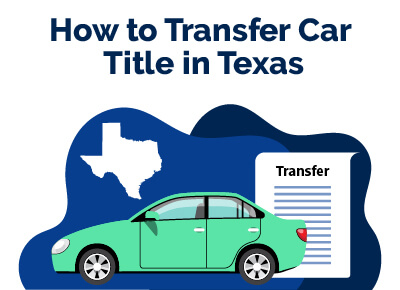How To Transfer a Car Title in Texas
February 27, 2024


Chris is Head of Content for FindTheBestCarPrice and is based out of Philadelphia, PA. As a seasoned automotive industry analyst and car enthusiast, he ensures the highest level of quality across all our content and curates our picks for the best deals each month.
Chris studied information systems and marketing at Drexel University and writes about a wide range of topics ranging from car buying tips to troubleshooting common mechanical issues.
When he’s not thinking about cars, he likes to stay in with his dog and make an “attempt” to finish a crossword puzzle (he’s not quite at the Saturday/Sunday level…yet). As a former cheesemonger, Chris still has a “sharp” passion for all things cheese, and his fridge is always loaded with it!
Chris also has a passion for things that go fast, and drones are no exception. He spends some of his time writing for Dronesourced.
If you have plans to buy and sell cars in Texas, you have only 30 days from the date of sale to transfer the title from the seller to the buyer.
So, how do you transfer a car title in Texas?
You can easily transfer car titles in Texas by:
- submitting a signed title
- including the date of sale
- marking the odometer reading with the sale of price
- applying for the title transfer
Read on to find out more about transferring car titles in Texas.
Key Takeaways
- You must transfer a car title in Texas within 30 days of purchasing a car.
- Dealerships often handle most of the process for the buyer.
- You can complete the title transfer online via the Texas Department of Motor Vehicles website.
- Required paperwork includes the Application for Texas Title and/or Registration (Form 130-U), contact details of the buyer, Vehicle Identification Number (VIN), and payment of fees and taxes.
Table of Contents
Can You Transfer a Car Title in Texas Online?
Partially. You can start to transfer a car title in Texas online.
visit the Texas Department of Motor Vehicles website for vehicle title transfer. Log in and proceed as a dealer in a county or commercial fleet buyer and proceed with your application.
However, you must go to a county tax office or a regional service center to sign the transfer.
What Paperwork Do I Need To Transfer a Title in Texas?
Here is the paperwork that you will need to transfer a title in Texas:
- Application for Texas Title and/or Registration (Form 130-U)
- Contact Details of the Buyer
- Vehicle Identification Number
- Fees and Taxes
How To Transfer a Car Title in Texas
Transferring a car title is the same as transferring ownership of a car. The process varies from buying cars from a dealer or an individual seller.
Transferring a car title from a dealer
If you are buying from a dealer, then the dealer will do everything for you. However, they must provide you with proof that the title has been transferred, with the new title bearing your name.
Transferring a car from an individual seller
If you bought a car from an individual seller, then you and the seller should go to the county tax office and transfer the title to avoid any issues.
Here’s a step-by-step guide on how to transfer a car title in Texas.
1. Title Application and Signing
The seller must provide you with a signed vehicle title. The seller must also pick up, complete, and sign the application for Texas Title and/or Registration (Form 130-U).
The title must include the VIN, name, and other information as provided by the seller.
What if the seller lost the title?
If the seller doesn’t have a title or misplaced it for any reason, they must apply for a duplicate.
As a seller, if a signed title is not provided, you may still be liable for whatever offenses committed with the car. In Texas, nobody should attempt buying or selling a car if there are no titles.
2. Confirmation and Documentation
Wait for confirmation, especially if you are dealing with an individual seller and not a dealer. During application, the tax office representative will help you verify that the title is “clean” and not “salvage” or “rebuilt.”
If you confirm that you are dealing with a clean title, then proceed with documentation. Submit the application for the Texas title and/or registration form that the seller provided. You might need to submit a lien release, if applicable.
If there is still a lien at the moment of application, the lienholder will receive the title after processing and completion.
The documentation might also require a power of attorney, depending on the circumstances surrounding the title, and photo identification that captures the buyer's legal name as stated on Form 130-U.
3. Odometer Disclosure
An odometer reading is necessary for a title transfer in Texas if the vehicle is less than 20 years old. The seller will do the odometer disclosure, sign it, and include it in the vehicle title.
4. Inspection (if applicable)
Vehicle inspections are needed for title transfer applications in Texas if there are no records of current inspections in the state’s database.
The inspection will ensure that the vehicle meets the required safety standard and emissions requirements. The seller must prove that the vehicle has never skipped any of the annual inspections.
5. Fees and Tax
Pay the required fees or any arising tax. The fees that you will pay for a title transfer in Texas vary depending on the county that you reside in.
For instance, Travis County, Texas, requires a title application fee of $33, but some counties charge $28. The fees will also vary depending on what you are paying for.
Here’s a list of fees you might have to pay for a title transfer in Texas.
- Vehicle title application: $28 or $33
- License plates fee: $51.75 base fee and $10 local fee
- Local and county fees: $31.50 (Max. Fee)
- Automation fee: $1
- Vehicle insurance verification fees: $31.50
- Vehicle inspection fee (state fees): up to $30.75 (additional fees might arise depending on the inspection station
- Sales Tax: 6.25% - 8.25%
6. Vehicle Transfer Notification
When the title transfer is done, sellers should download and complete the Texas Motor Vehicle Transfer Notification (VTR-346) form.
You must submit the form within 30 days from the date of title transfer to the vehicle's new owner.
The vehicle transfer notification does not replace the need for a title application. After submitting this form, you must advise the buyer to start their title application.
The beauty of the vehicle transfer notification form is that you can do it electronically at the Texas Motor Department’s official website.
Upon completion of the form, mail your response to:
TxDMV Vehicle Titles and Registration Division
PO Box 26417
Austin, TX 78755-0417
Conclusion
Transferring a car title in Texas can look a bit confusing, especially if it is your first time. However, if you follow the steps in this guide, you will get a smooth and hassle-free experience.
Ensure you gather all the necessary documents, fill your applications correctly and avoid mutilations. Don’t forget to book an appointment before your day of visit to ensure that you are attended to promptly.
Learn how to transfer a car title in any state by checking out our guides!
Best Car Deals by Category
Frequently Asked Questions
How much does it cost to transfer a car title in Texas?
Transferring a car title in Texas costs between $28 and $33. However, this excludes license fees, local fees, or tax. However, the overall cost of title transfer varies depending on the county where you reside.
How long does a title transfer take in Texas?
In Texas, title transfers take at least 20 business days to complete. If your title doesn’t arrive after 30 business days, you must contact any regional service center or tax office near you, preferably the one that started your application.
What is the penalty of not transferring a car title within 30 days in Texas?
You must pay a $25 late transfer penalty, and an additional $25 for every additional 30 days that goes by (up to $250).
Do you need an appointment to transfer a title in Texas?
Yes. You need an appointment to transfer a title in Texas. However, it is not compulsory. Applicants and drivers without a title transfer will be attended to across all 16 department offices in Texas. However, customers with appointments will be given a top priority amongst others.
What documents do I need to transfer a title in TX?
You need:
- the original title
- title application form
- Government-issued ID
- Proof of Texas liability insurance
- Proof of sale
Can you transfer a title without an inspection in TX?
You can transfer a car title without inspection in Texas only if it is a "title-only" transfer, meaning you will need to complete registration separately.
Posted in Car Buying Tips, Car Troubleshooting |




